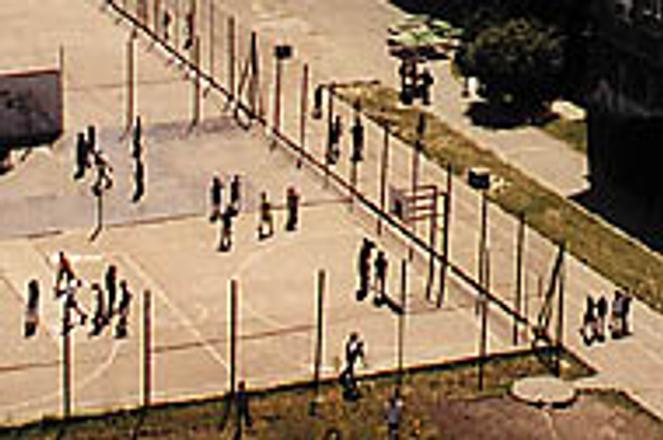Administrators at this Bratislava elementary school say that they have been told little of nearby contaminated land.photo: Ján Svrček
A heavily-populated area of Bratislava is sitting on top of an environmental disaster, according to a study commissioned by the builder of a bridge in the district.
The study, which was carried out this May by the Geohyco firm, found that a large area of land in the Ružinov district of the capital around Mlynské Nivy and Košická streets is contaminated with oil, gas and carcinogenic materials - some of which are escaping into the atmosphere. Geohyco based the findings on eight test drillings at various sites; the contamination is located between two and seven metres below current ground level.
The results of the study were released in late June by Vladimír Kovalčík, chairman of the board of the Metro corporation, the main investor behind a 3.6 billion Slovak crown ($70 million) project to build a new bridge, known as Košická most, connecting Bratislava and the 130,000-population suburb of Petržalka across the Danube River.
The original contamination was caused 56 years ago when the US air force bombed the former Apollo oil refinery on the banks of the Danube at the end of World War II. It was then exacerbated by leaks from the former Chemika chemical factory.
For modern-day Bratislavans, the findings imply that hundreds of children at a school on Košická Street play daily on land containing slowly-leaking pollutants such as methane, pentane, hexane, heptane and octane - gases Geohyco warned could collect in explosive quantities.
The siteof underground contamination, where deadly pollutants are trapped two to seven metres below ground.photo: Ján Svrček
The 24-storey Slovakopress building, the Centrum Bottova shopping centre and possibly even the nearly-complete Slovak National Theatre - where thousands of people work and shop every day - also lie on land showing concentrations of the carcinogenic gases trichlorethlene and tetrachlorethlene. The area is also densely settled with housing estates and other businesses.
Metro's Kovaĺčík, commenting on the findings for The Slovak Spectator, expressed surprise that the contamination was not on record at the Geofond institute, a state agency which is supposed to register all findings of test drillings.
"Those in power probably tried to hush it up," said Kovalčík, remarking that the pollution had been unofficial knowledge since the wartime bombing.
Dagmar Krajčovičová, the accountant for the school on Košická street, said that administrators had been told little of the dangers resulting from the school's proximity to the dangerous gasses. "But I think we should be informed about such dangers in detail," she said June 27. "There are 1,300 pupils at this school!"
One doctor in Žilina, who asked not to be identified, said that depending on exposure levels, the gasses provided potentially lethal dangers to the students and residents of the area in question. The Slovak Environment Ministry, meanwhile, refused to answer questions asked by The Slovak Spectator.
What to do
"There are two basic problems here - the level of gases buried in the earth, and their leaking into the atmosphere, because they are highly explosive," said Martin Murín, head of the Bratislava-based Ecotoxology Centre, for the daily paper Hospodárske noviny.
However, few know what to do about either problem. Kovalčík reported that he had informed Bratislava city officials of the results of the survey, and expected that a crisis commission would be set up quickly to find a solution to the contamination.
He said there were two possibilities - either for all parties to work together to clear up the entire mess, with the city footing the bill, or for Metro to cover the costs of a far smaller clean up limited to the land which its bridge construction would affect. "Personally, I'm in favour of the joint approach," said Kovalčík, adding that Metro could cover the estimated 150 million crown costs of the smaller clean-up from a project reserve fund.
But a citizens' group opposing the construction of the bridge for other reasons has accused Metro of using the survey for its own ends.
Lenka Zentková, a member of the Bridge No. 5 group, said that "the problem of contaminated earth has been known unofficially for years; it's just that it suits the investor to use the issue now to conceal one environmental problem behind another, to take the public's attention away from the negative effect the Košická Bridge would have on local living conditions."
Bridge No. 5 opposes the new project because it would bring far more traffic, noise and air pollution to what has historically been a quiet and peaceful Bratislava neighbourhood.
Zentková added that it was not a real option to decontaminate the entire area, because "for that we would need to raze the entire neighbourhood and rebuild it anew. The investor wants to create the impression that construction of the bridge would be an opportunity to clean up the entire neighbourhood, but in reality it's only about decontaminating land around the bridge."
"We are opposed to the bridge's construction because of the increased noise levels and the affect that the increased traffic will have on the neighbourhood," added Krajčovičová. "We just don't have much information about this contamination right now."


